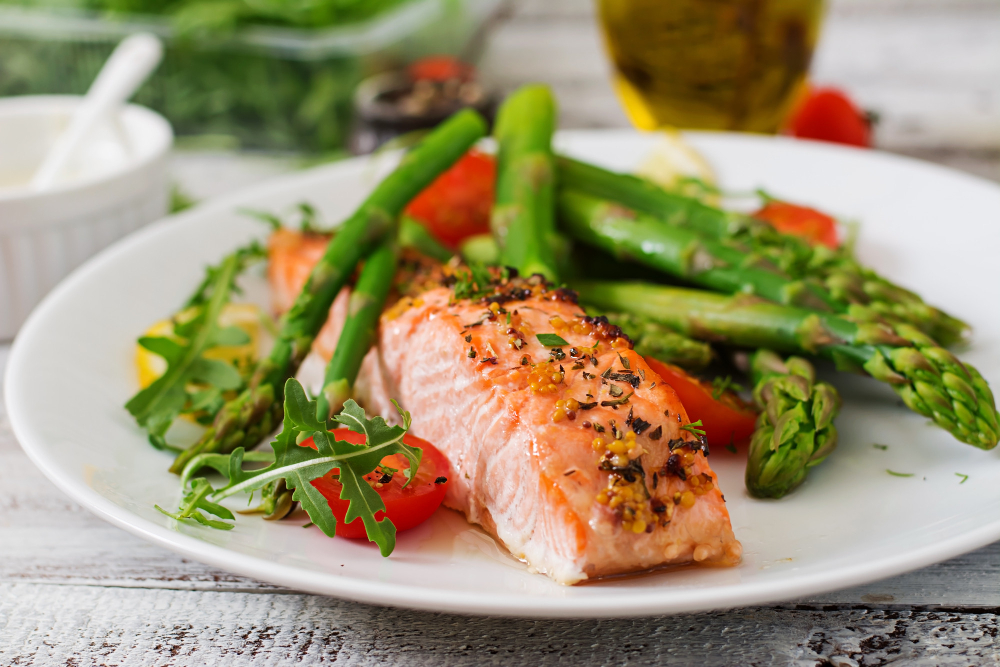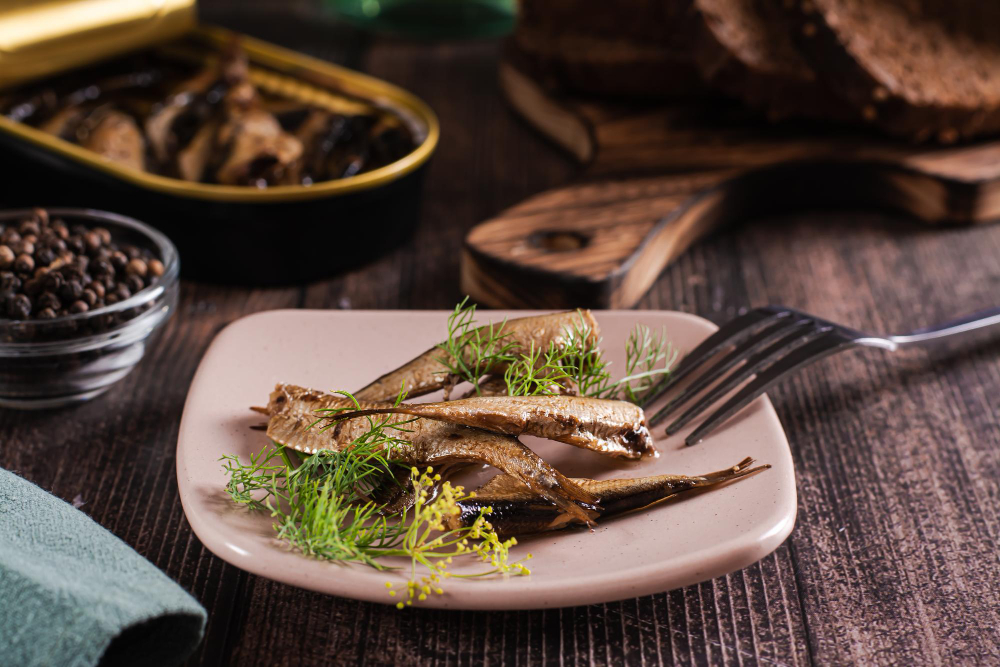- Fast results
- 4,000+ locations
- 4.8 star rating
Need Help? (888) GET LABS


Fish is an excellent source of protein and fatty acids. However, not all fish are equal in terms of nutrient concentration and safe consumption. While some are touted for their positive impact on heart health, others are more exposed to toxins like mercury that could jeopardize your health. That said, here are the best fish to eat to complete a holistic diet.
You can never go wrong with salmon if you’re looking for fish with high concentrations of omega fatty acids. According to FoodData Central, 100 grams of farmed Atlantic Salmon(1) contains 2.15 grams of combined EPA (eicosapentaenoic acid ) and DHA (docosahexaenoic acid)–the two primary omega-3 fats found in cold-water fish.
Salmon is also rich in other nutrients like protein, phosphorus, potassium, selenium, vitamin A, vitamin D, and more. It also has low calories, making it one of the best fish to eat for weight loss.
Aside from its high nutritional value, salmon is the best freshwater fish to eat due to its low mercury content(2). This means it’s far safer than swordfish and king mackerel, two of the highest mercury-concentrated fish.

Two types of salmon are marketed for consumption: farmed and wild-caught salmon. Both types provide rich nutrients, from protein and healthy fats to various vitamins and minerals. The main difference between the two is the environment and diet these salmon are exposed to, leading to flavor and nutritional concentration variations.
For example, protein in a 100-gram wild-caught salmon is 25.4 grams(3), while farmed salmon in the same amount has 22.1 grams(1). Plus, wild salmon is said to have a richer flavor than farmed salmon.
However, many consumers also lean toward farmed salmon for two reasons. First, farmed salmon are less expensive than their wild counterpart. Additionally, it is deemed safer in terms of contamination as farmed salmon’s environment is regulated, whereas wild-caught salmon are more susceptible to toxin exposure.
Salmon can be consumed in many ways. For example, you can have it pan-fried for dinner with just the basic salt and pepper seasoning. It’s easy to prepare and remains a well-known star at the dinner table.
Grilled and baked salmon preps are also great options for serving this healthy fish. You can eat them as they are, mix them with salads, add a few veggies on the side, or pair them nicely with grains like lemony couscous.

Sardines consistently made the list of fish with the lowest mercury concentrations(4). It also remained a ubiquitous meal source in the market, making it highly available anywhere in the world.
On top of its market presence, sardines are packed with nutrients. Canned sardines in oil(5) contain 24.6 grams of protein, 383 milligrams of calcium, 39 milligrams of magnesium, and over 300 milligrams of other electrolytes like potassium, sodium, and phosphorus, calculated individually.
Sardines hold a high level of versatility as far as recipes go. You can heat canned sardines and pair them with bread or crackers. You can also toss it into a salad, sautee a few in oil, put it on top of rice, stuff them in peppers, and mix it with pasta.
If you’ve ever gone fishing, you probably know why trout are popular targets in a creek. Trouts are often highly prized by fishing enthusiasts as species like the rainbow trout can grow huge, making them more challenging to pull out of the water. Thus, the satisfaction of being able to fish these trouts triggers a sense of accomplishment.
But on top of being excellent game fish, rainbow trout is rich in omega-3 fatty acids, niacin, and electrolytes(6). In fact, you’ll get as much as 377 milligrams of potassium, 5.57 milligrams of niacin, 11 micrograms of folate, and other vitamins and minerals from 100 grams of farmed rainbow trout.
| Pro tip: Pregnant women need folates to ensure proper fetal brain development. Aside from trout, here are the other best sources of folates. |
Rainbow trout is hailed as one of the best freshwater fish to eat, not only for its high nutritional value but for its unique nutty flavor and practical preparation. Like other large freshwater fish, you can make rainbow trout the center of your meal. You can have it baked, grilled, roasted, poached, or sauteed.
Add some vegetables, like asparagus and green beans. Drizzle it with lemon juice and butter, plus some roasted tomatoes on the side, and you have a tasty dish that will impress anyone partaking in the meal.
The herring is another type of fatty fish with high levels of long-chain omega-3. It is undoubtedly a top contender for the best white fish to eat for its plethora of health benefits, which include improved heart health and protection against anemia.
Herrings (100 grams) have iron at 1.41 milligrams. It has protein at 23 grams, vitamin B12 at 13.1 micrograms, and vitamin A at 36 micrograms(7). In addition, herrings also have low mercury content, making them safe for consumption.
You can get herring in various forms, ranging from canned and pickled to smoked and fresh. It’s already tasty as it is, but the many forms of preparation make its soft flesh even more flavorful.
One of the most popular ways to eat herring is by having it grilled, which is best for fresh fillets. Pickled herring is excellent for sandwiches and as a key ingredient for many appetizers. You can also have it sauteed in butter, fry, or mix it with salad.
If you love pizza, you might have noticed that anchovies are one of this staple meal’s (if not the only) fish toppings. But anchovies are not just tasty, with their distinct briny flavor; they also bring health benefits through their nutritional content.
Like other fish in this list, anchovies are an excellent source of omega-3 fatty acids that promote cardiovascular health. It’s also packed in iron at 3.25 milligrams per 100 grams(8). You can also get rich amounts of calcium, selenium, magnesium, vitamin B12, etc.
| Pro tip: Iron is an essential nutrient for red blood cell production. If you have low iron, you are at risk of anemia. Plus, it can also trigger female hair loss. |
Anchovies are versatile as they are delicious. They usually come in cans, but you can also buy fresh anchovies from the market.
Aside from using them as toppings on pizzas and toasts, you can have anchovies mixed with pasta recipes, salads, and sauces. You can have them grilled, smoked, fried, baked, and marinated.
A popular fish on the Florida coast, mahi mahi is a bright green and yellow large fish known to have low calories but high concentrations of vitamins and minerals.
For every 100 grams of cooked mahi mahi, you get 23.7 grams of protein(9). You also get selenium, magnesium, calcium, phosphorus, vitamin A, and many more. These nutrients play significant roles in cellular metabolism, muscle building, and boosting heart health.
Mahi mahi fillets with lemon and butter are not just delicious but also simple to prepare. You can have the fillets pane-seared or baked with all the ingredients in one pan. Grilled mahi mahi is another great way to prepare this healthy fish if you wish to incorporate a smoky taste that elevates the flavor of the flesh.
Whichever way you choose to cook mahi mahi, you’ll be delighted to know that it pairs up with all sorts of side dishes, vegetables, and fruits. You can serve it with asparagus, broccoli, pineapple salsa, and rice.
Fish high in mercury, like swordfish, shark, tuna, king mackerel, and marlin, have unhealthy effects. Repeated mercury exposure can cause brain problems and other health issues. It is particularly more adverse in specific populations. For example, fish with elevated mercury concentrations is prohibited in pregnant and breastfeeding women, as well as young children. Their risk of mercury toxicity is higher, and the adverse impact can become irreversible.
Because fish is exposed to many toxins, whether farmed or wild-caught, it is not generally recommended to consume it daily. But because it’s a rich source of omega-3 fatty acids, you can eat fish twice a week to get the most health benefits.
While it is not discouraged to avoid fish per se, you may want to limit consumption if you’re pregnant. A developing fetus must not be exposed to common toxins, let alone mercury, during the gestational period. However, that’s not to say you should exclude fish completely. Instead, consult your doctor about which type of fish you should include in your diet and which ones you should avoid.
The best fish to eat for health is always the one with the most nutrients and less toxins. Why you may buy fish for its refreshing flavor, understanding where it is on the health scale makes your buying decision more informed and beneficial. Whether you’re losing weight, protecting your heart health, or increasing your nutrient consumption, keep these six healthiest types of fish on your next grocery list.
1 U.S. DEPARTMENT OF AGRICULTURE (2019, April 1). Fish, salmon, Atlantic, farmed, cooked, dry heat. Https://fdc.nal.Usda.gov/. Retrieved January 27, 2024, from https://fdc.nal.usda.gov/fdc-app.html#/food-details/175168/nutrients
2 Smith KL, Guentzel JL. Mercury concentrations and omega-3 fatty acids in fish and shrimp: Preferential consumption for maximum health benefits. Mar Pollut Bull. 2010 Sep;60(9):1615-8. doi: 10.1016/j.marpolbul.2010.06.045. Epub 2010 Jul 14. PMID: 20633905.
3 U.S. DEPARTMENT OF AGRICULTURE (2019, April 1). Fish, salmon, Atlantic, wild, cooked, dry heat. Https://fdc.nal.Usda.gov/. Retrieved January 27, 2024, from https://fdc.nal.usda.gov/fdc-app.html#/food-details/171998/nutrients
4 Shiber, John. (2010). Arsenic, cadmium, lead and mercury in canned sardines commercially available in eastern Kentucky, USA. Marine pollution bulletin. 62. 66-72. 10.1016/j.marpolbul.2010.09.008.
5 U.S. DEPARTMENT OF AGRICULTURE (2019, April 1). Fish, sardine, Atlantic, canned in oil, drained solids with bone. Https://fdc.nal.Usda.gov/. Retrieved January 27, 2024, from https://fdc.nal.usda.gov/fdc-app.html#/food-details/175139/nutrients
6 U.S. DEPARTMENT OF AGRICULTURE (2019, April 1). Fish, trout, rainbow, farmed, raw. Https://fdc.nal.Usda.gov/. Retrieved January 27, 2024, from https://fdc.nal.usda.gov/fdc-app.html#/food-details/173717/nutrients
7 U.S. DEPARTMENT OF AGRICULTURE (2019, April 1). Fish, herring, Atlantic, cooked, dry heat. Https://fdc.nal.Usda.gov/. Retrieved January 27, 2024, from https://fdc.nal.usda.gov/fdc-app.html#/food-details/175117/nutrients
8 U.S. DEPARTMENT OF AGRICULTURE (2019, April 1). Fish, anchovy, european, raw. Https://fdc.nal.Usda.gov/. Retrieved January 27, 2024, from https://fdc.nal.usda.gov/fdc-app.html#/food-details/174182/nutrients
9 U.S. DEPARTMENT OF AGRICULTURE (2019, April 1). Fish, mahimahi, cooked, dry heat. Https://fdc.nal.Usda.gov/. Retrieved January 27, 2024, from https://fdc.nal.usda.gov/fdc-app.html#/food-details/171992/nutrients

© Copyright 2025 Personalabs. All Rights Reserved.